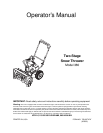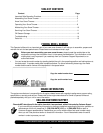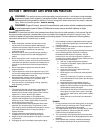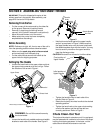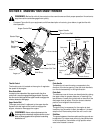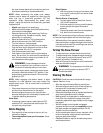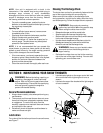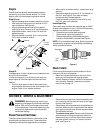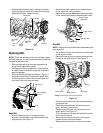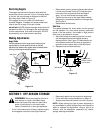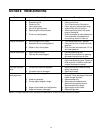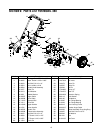
9
the snow thrower starter will normally be used, one
should be installed by a licensed electrician.
NOTE: When connecting the power cord, always
connect cord to starter on engine first, then plug the
other end into a three-hole grounded 120 Volt
receptacle. When disconnecting the power cord,
always unplug the end from the three-hole, grounded
receptacle first.
• Attach spark plug wire to spark plug.
• Make sure that the auger control bail and the drive
control bail are disengaged.
• Remove the keys from the plastic bag. Push key
into the ignition slot. Do not turn the key. Keep
second key in a safe place.
• Move the choke knob to FULL choke position.
• Move throttle control to the FAST position.
• Turn fuel valve on, if so equipped.
• Connect power cord to the switch box on engine.
• Plug the other end of the power cord into a three-
hole, grounded 120 volt A.C. receptacle.
• Push primer button three times.
• Push down on the starter button until the engine
starts. Do not crank for more than 20 seconds at a
time. Allow the electric starter to cool down for 10
minutes before cranking again.
• When the engine starts, release the starter button
and slowly rotate the choke to OFF position. If the
engine falters, rotate the choke to FULL and then
gradually to OFF.
NOTE: When engaging the electric starter, a slight
hesitation of a few seconds may occur before the
engine starts to turn. This is normal and is not harmful
to the engine.
• Disconnect the power cord from the receptacle first
and then from the switch box on the engine.
• Allow the engine to warm up for a few minutes
because the engine will not develop full power until
it reaches operating temperature.
Warm Start:
• If restarting a warm engine, rotate choke to OFF
instead of FULL and press the starter button. Do
not push the primer button.
Before Stopping
• Run engine for a few minutes to help dry off any
moisture on engine.
• To avoid possible freeze-up of the starter, follow
these steps:
Recoil Starter
a. With the engine running, pull the starter rope
with a rapid, continuous full arm stroke three
or four times.
Electric Starter (if equipped)
a. Connect power cord to switch box, then to
120 Volt AC receptacle.
b. While the engine is running, push the starter
button and spin the starter for several
seconds.
c. Disconnect power cord from the receptacle
first, then from the snow thrower.
NOTE: The unusual sound from pulling the starter rope
or from spinning the starter will not harm the engine.
• While standing in the operator’s position (behind
the snow thrower), engage the auger control bail for
a few seconds to clear any remaining snow and ice
from the discharge chute.
To Stop The Snow Thrower
• To stop the wheel, release the drive control bail.
• To stop throwing snow, release the auger control bail.
• To stop engine, push throttle control lever to OFF
and pull out the key. Do not turn key.
• Wipe off all snow and moisture from the carburetor
area and around the engine.
Clearing The Snow
CAUTION: Check the area to be cleared for foreign
objects. Remove, if any.
• Start the engine following Starting instructions.
• Allow the engine to warm up for a few minutes as
the engine will not develop full power until it
reaches operating temperature.
• Rotate the discharge chute to the desired direction,
away from bystanders and/or buildings.
• Making certain no bystanders or obstacles are in
front of the unit, squeeze the auger control bail
completely against the upper handle to fully engage
the augers.
• While the auger control handle is engaged,
squeeze the drive control bail completely against
the upper handle to engage the wheels. Do not
“feather” the drive control bail.
• As the snowthrower starts to move, maintain a firm
hold on the handle, and guide the snowthrower
along the path to be cleared.
• Release the bails to stop the snowthrowing action
and forward motion.
WARNING: Severe damage to electric
starter is possible if you continue to crank for
more than 20 seconds without a cool-down.
WARNING: The temperature of muffler and
the surrounding areas may exceed 150
o
F.
Avoid these areas.



